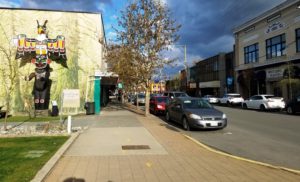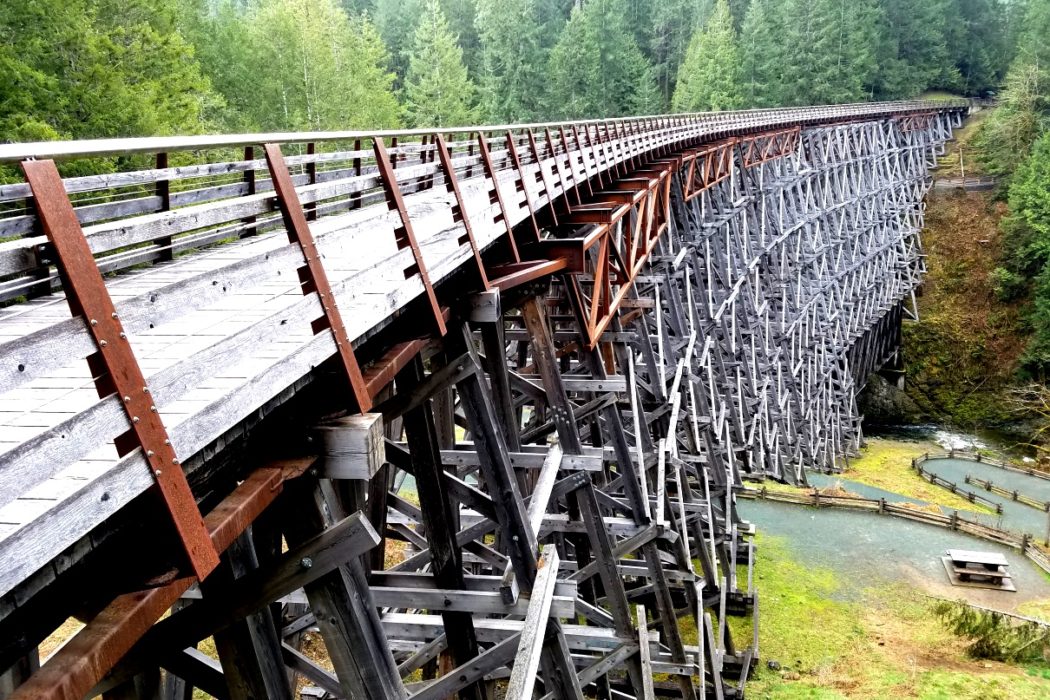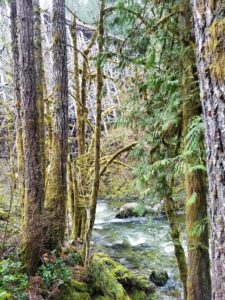I (Storm Cunningham) was on lovely Vancouver Island in British Columbia, Canada for a couple of weeks last year, keynoting conferences for local watershed groups.
As my wife (Maria) and I traveled around in our rented Jeep Wrangler, one of the many community and economic revitalization opportunities that struck me hardest lay in the restoration of the island’s rail service. The boost to the tourism economy alone would be tremendous.
Now, the engineering firm WSP Canada Group Ltd. apparently sees the same opportunity. They were hired by the BC Ministry of Transportation and Infrastructure to do an assessment of the remaining disused rail infrastructure.
Apparently, it will cost some $326 million (CDN) to restore rail service.

Historic downtown Duncan, a city that would benefit from the restoration of rail service. Many local residents currently commute by car to Victoria. Photo by Storm Cunningham.
WSP’s up-to-date, in-depth track and bridge assessment will be used by government to inform future decisions on investments in the corridor, which is owned by the Island Corridor Foundation.
This was a thorough assessment conducted by railway industry experts to ensure a complete and accurate picture of the railway infrastructure, from ties and track to grade crossings and bridges.
The entire length of the Island Rail Corridor was assessed: Victoria to Courtenay (Victoria subdivision), Parksville to Port Alberni (Port Alberni subdivision), and Wellcox Spur and Wellcox Yard (near Nanaimo).
The final report includes estimated costs to upgrade infrastructure to restore rail freight operations and passenger service on Vancouver Island.
It also includes cost estimates to upgrade the rail line to meet the standards needed to implement a commuter service with frequent train service between Victoria and Langford (Westhills), as well as inter-city service between Victoria and Courtenay.
The ministry is currently developing the South Island Transportation Strategy, focusing on the efficient movement of people and goods. The strategy will look at all modes of transportation across southern Vancouver Island, including rail. The strategy is expected to be released in June.
The Ministry of Transportation and Infrastructure engaged WSP Canada Group Ltd. to conduct the detailed evaluation of the Island Rail Corridor on Vancouver Island.
As you can see in the featured photo, the most spectacular part of the island’s rail system in the Kinsol Trestle, also known as the Koksilah River Trestle. It’s a wooden railway trestle located north of Shawnigan Lake, and provides a spectacular crossing of the Koksilah River.
Completed in 1920, it measures 44 meters (144 ft) high and 188 meters (617 ft) long, making it the largest wooden trestle in the Commonwealth of Nations and one of the highest railway trestles in the world.
It was built as part of a plan to connect Victoria to Nootka Sound, passing through Cowichan Lake and Port Alberni, when forestry had gained some ground on Vancouver Island and a more efficient way to transport the region’s huge, old-growth timber was needed. It was not built, as some mistakenly believe, to serve any nearby mines.
It was named after the nearby Kinsol Station which, in turn, took its name from a nearby mining venture grandiosely named “King Solomon Mines”, a very small mining venture that produced 18 tons (19.8 short tons; 17.7 long tons) or 18,000 kg or 39,683 lb of copper and 6,300 g (203 ozt) of silver (from 254 tons or 280 short tons or 250 long tons of ore—hardly enough to fill 3 rail cars) over the period from 1904–1907 .
The line was started in 1911 by the Canadian Northern Pacific Railway (CNoPR) and while it was designed by engineers, it was built by local farmers and loggers. It was funded by the Canadian Western Lumber Company, which was the largest lumber company in the world at the time.
The trestle was never completed by the CNoPR, and the line only reached Youbou before construction was terminated. The CNoPR was taken over by Canadian National Railways in 1918, and its line and the trestle were completed in 1920 as part of the “Galloping Goose” rail line.
The last train to cross the Kinsol was in 1979, and the trestle was abandoned 1 year later. I, for one, look forward to seeing this spectacular view once again, but this time from inside a rail car.
Photo of the historic wooden Kinsol Trestle on Vancouver Island by Storm Cunningham.


